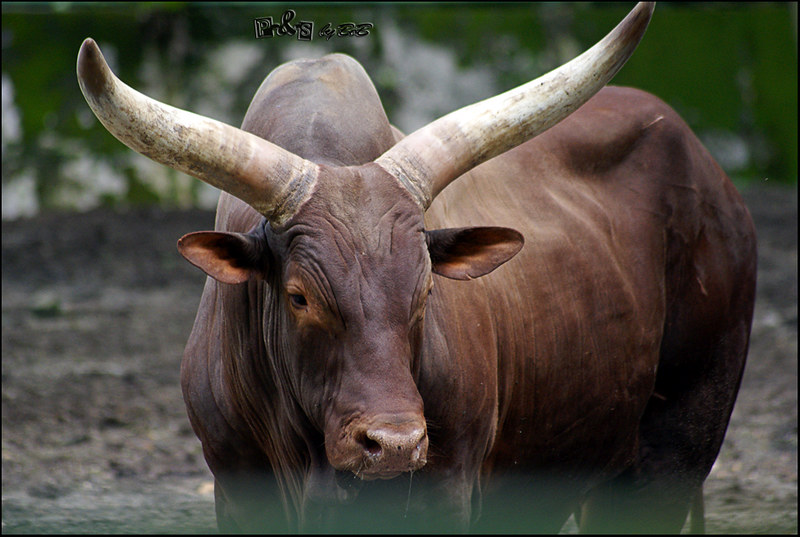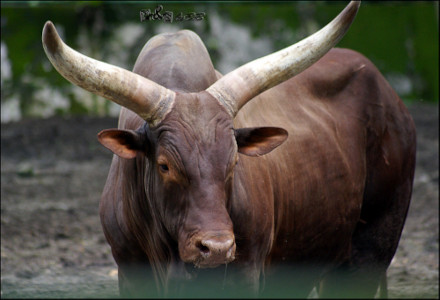
Photographer: bob|P-&-S
CC License: https://bit.ly/2VELGUn
Ankole-Watusi Facts
- Perhaps most notably, the distinctive term of Ankole-Watusi serves as the common name for a very impressive looking type of bovine. This remarkable breed, a species of Sanga cattle, principally remains famous for its gargantuan horns.
- In the wild, the numbers of the supremely impressive animal declined quite rapidly in the past. As a direct consequence, the IUCN once listed the magnificent species as Endangered, on its Red List of Threatened Species.
- Quite fortunately, its numbers later increased sufficiently enough that the organization subsequently removed it from the Endangered List. It should also be noted that this numerical increase occurred partly due to a particular action of mankind.
- Captive breeding practices for the Ankole-Watusi continue, since its appearance makes these impressive creatures extremely popular as show animals. Although it’s not something we support, it’s perhaps better than just slaughtering it for the horns.
Related Articles
Photographer: Steven Miller
CC License: https://bit.ly/2ydoWim
Ankole-Watusi Physical Description
With the obvious exception of the horns, the astounding Ankole-Watusi forms a medium-sized type of cattle. This trait has also remained consistent throughout its domestication. This fact elegantly proves the principle that size has no bearing with impressiveness.
It also shows a moderate degree of sexual dimorphism, a common trait among mammals. Females typically attain a maximum weight of only about 1,200 lb (540 kg). Meanwhile, males of the species usually reach an upper-limit weight of roughly 1,600 lb (730 kg).
In color, though, the genders of this animal remain virtually identical in appearance. Individuals most typically display a solid dark brown. Nonetheless, some individuals may display white spots or blotches, as well.
Its most distinctive and most noteworthy feature, of course, remains the extremely large horns. These have an incredible nature. In fact, these actually grow honeycombed with numerous blood vessels, to aid in cooling the large animal.
The Ankole-Watusi also often uses the horns with respectable effectiveness in defense of the individual or the young. That’s quite understandable. The span of these incredible horns may be as much as 8 ft (2.4 m) from tip to tip.
- Kingdom: Animalia
- Phylum: Chordata
- Class: Mammalia
- Order: Artiodactyla
- Family: Bovidae
Public Domain Image
Ankole-Watusi Distribution, Habitat, and Ecology
The marvelous Ankole-Watusi evolved as endemic to a restricted portion of the world. Further, that region consists of one not normally associated with domestication. It lives only in the Saharan regions of the continent of Africa.
However, it also adapted quite well to, and subsequently established itself in, several other regions of the globe. These alternate introduced regions include Europe, Australia, and both North America and South America.
For all its amazing traits, some factors remain consistent within its genus. This astonishing mammal shares a very specific basic physiological trait with related creatures. That holds true due to the nature of its lifestyle.
This marvelous creature evolved to have an entirely herbivorous diet. In this respect, it remains like other bovines. Also like its many relatives, this mainly consists of various native plant species, such as grasses and leaves.
The species also evolved an effective defense pattern. The entire herd sleeps together at night, with the calves placed in the center. Furthermore, the larger bulls sleep along the outer rim, with the horns facing outwards.
Due to its many incredible attributes, the Ankole-Watusi holds the dubious distinction of being one of the earliest confirmed domesticated animals. Records indicate that its domestication began at least 6,000 years ago.
Species Sharing Its Range
Fennec Fox Cheetah Somersaulting Spider
Check out our other articles on 7 Magnificent Wild Canines, Himalayan Blue Poppy, Dragon Moray Eel, Cano Cristales, Plume Moth, Green Sea Turtle, Snowy Owl, Aardwolf

